- within Intellectual Property topic(s)
- in United States
- with readers working within the Technology industries
- within Cannabis & Hemp, Privacy, Media, Telecoms, IT and Entertainment topic(s)
A recent court case in the Eastern District of New York is a great example of "another bite at the apple" of patent subject matter eligibility. This, hopefully, is the time to recognize that software and artificial intelligence-related tools are technically valuable and much more than the automation of human activities.
For the last thirty years, inventors have faced unique challenges in patenting imaging methods and equipment used to diagnose the need for dental and prosthetic implants. The conventional field has been crowded with pre-existing patents covering basic principles of imaging technologies — such as X-rays, CT scans, and 3D modeling. As a result, applicants seeking protection for new developments often struggle to demonstrate novelty and non-obviousness to the U.S. Patent and Trademark Office (USPTO).
The subject matter eligibility requirement under 35 U.S.C. § 101 is another significant hurdle to image data analysis. Courts and the USPTO have increasingly become more rigorous in rejecting claims directed to "abstract ideas" — a category that can envelop diagnostic imaging methods, especially those that largely involve data processing or mathematical algorithms.
For instance, imaging techniques that rely on software to interpret anatomical data may be viewed as abstract unless they are tightly integrated with novel hardware or bring about a tangible, technical improvement. However, the uniformity and effectiveness of software to analyze such anatomical data clearly constitutes a technical innovation with real world applications not provided by human clinicians alone.
The patenting of innovations related to anatomical imaging for implants (dental or otherwise) often requires careful claim drafting to distinguish between what's patent-eligible and what belongs to the realm of surgical techniques, which are non-patentable under 35 U.S.C. § 287(c). Furthermore, generating robust supporting experimental data is crucial to demonstrate the clinical benefit and accuracy of a new technique — a process that can be lengthy and expensive.
Thus, innovators, often clinicians in private practice with real world experience, must rely on their legal counsel to assist in strategically navigating these legal and technical hurdles, combining inventive hardware, advanced algorithms, and clear practical applications to secure enforceable patents in this highly competitive and evolving area.
This, hopefully, is the time to recognize that software and artificial intelligence-related tools are technically valuable and much more than the automation of human activities.
The content of this article is intended to provide a general guide to the subject matter. Specialist advice should be sought about your specific circumstances.


